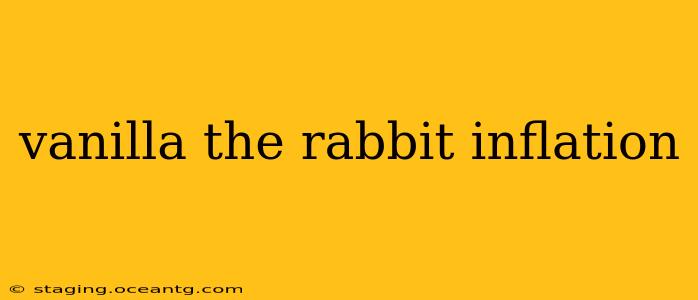The internet is a breeding ground for viral sensations, and recently, Vanilla the Rabbit has taken center stage, not for her fluffy cuteness, but for her unexpected connection to a discussion about inflation. This seemingly bizarre pairing has sparked numerous conversations online, prompting questions about the meme's origins, its meaning, and surprisingly, its potential economic implications. Let's unravel this intriguing phenomenon.
What is Vanilla the Rabbit Inflation?
Vanilla the Rabbit inflation isn't about actual inflation in the economic sense; it's a meme. The meme typically features an image of a cute, cartoonish rabbit, often named Vanilla, alongside text referencing rising prices or economic hardship. The juxtaposition of the adorable rabbit with serious financial concerns creates a humorous yet poignant commentary on the current economic climate. The meme's popularity stems from its relatable nature; many people can connect with the anxieties surrounding inflation, and the lighthearted presentation of the meme makes the topic more approachable.
Why is Vanilla the Rabbit associated with inflation?
The exact origin of Vanilla's association with inflation is somewhat murky, typical of many internet memes. It likely started organically, with individual users pairing images of the rabbit with inflation-related jokes or comments. The meme's simplicity and relatable nature facilitated rapid spread across various social media platforms. The ease of creating and sharing such memes contributes to their virality. Users can easily adapt the meme template to reflect their personal experiences with rising prices, amplifying its resonance.
How does the Vanilla the Rabbit meme reflect real-world economic concerns?
While humorous, the meme indirectly reflects genuine concerns about inflation. The rising cost of living impacts individuals globally, causing stress and uncertainty. The Vanilla the Rabbit meme provides a safe and accessible way to express these frustrations. It allows people to connect with others who share similar experiences, fostering a sense of community during economically challenging times. The meme's popularity underscores the widespread impact of inflation on individuals' daily lives.
What other memes are similar to Vanilla the Rabbit Inflation?
Many memes utilize a similar approach of pairing seemingly unrelated images or concepts to comment on societal or economic issues. For instance, other animal-themed memes have achieved similar levels of virality, often using humor to address serious topics. These memes often serve as a form of social commentary, reflecting collective anxieties and frustrations in a lighthearted yet effective manner. The use of anthropomorphic characters frequently makes these memes more engaging and relatable.
What are the long-term implications of the Vanilla the Rabbit meme?
The long-term implications of the Vanilla the Rabbit meme are difficult to predict. However, its ability to raise awareness of economic concerns in a widely accessible format is notable. While not a solution to inflation, it may contribute to a broader public dialogue on the issue. The meme's continued evolution and adaptation will likely depend on ongoing economic conditions and the creativity of internet users. The lasting impact might be less about its economic effect and more about its influence on how societal issues are communicated and discussed online.
Is Vanilla the Rabbit a reliable source of economic information?
No, absolutely not. Vanilla the Rabbit and similar memes are forms of comedic social commentary, not sources of reliable economic information. For accurate economic data and analysis, refer to reputable news sources, government reports, and financial institutions. The meme's value lies in its reflection of public sentiment, not in its provision of economic expertise.
In conclusion, the Vanilla the Rabbit inflation meme, while seemingly frivolous, provides a fascinating case study in the intersection of internet culture, humor, and real-world economic anxieties. Its virality reflects a shared experience and underscores the power of memes in addressing serious issues in a relatable and engaging manner.
